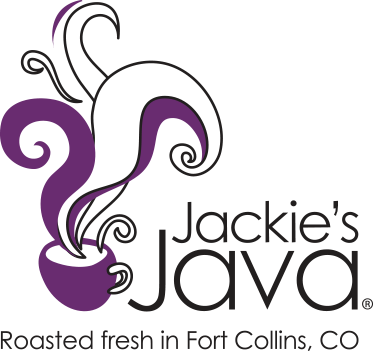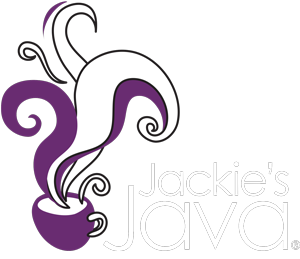
What makes our coffee great: Our roasting technique
At Jackie’s Java, we strive to produce the highest quality and best tasting coffee around. One way we like to set ourselves apart from the rest of the roasters out there is our roasting technique. We roast our coffee in a way we have found best captures the flavors of each bean, making our coffee stand out from the rest.
Post roast blending
 Coffee beans are like baked goods. You wouldn’t bake brownies, break-and-bake chocolate chip cookies, and homemade sugar cookies at the same temperature for the same amount of time. Some of them would be undercooked, some would be burnt, and they would all taste bad.
Coffee beans are like baked goods. You wouldn’t bake brownies, break-and-bake chocolate chip cookies, and homemade sugar cookies at the same temperature for the same amount of time. Some of them would be undercooked, some would be burnt, and they would all taste bad.
Every different type of coffee bean has a different moisture content and density and they each need to be roasted in a specific way to extract the optimal flavor. Big coffee roasters will roast all their beans (Brazilian, Columbian, Ethiopian, etc.) in one batch all at the same temperature. The only thing they adjust is how long the beans are roasted for. There’s no art to it.
We have blends just like big roasters do, but we do it a little differently. We roast all our beans separately on their own profile to bring out each bean’s perfect flavor. When roasting each bean, we adjust many different things that can change how the coffee tastes.
We adjust the airflow when beans are roasting. Some beans you want roasting in their own smoke, creating a smokey flavor. But sometimes you don’t want that smokey flavor, so we adjust the airflow to make sure the beans are roasting in fresh air and all the smoke is released out of the roaster. And sometimes you want a little mix of both, that’s why we adjust the airflow.
We adjust the temperature the beans are roasted at and the amount of time they are at that temperature. The rate of increase in temperature is important to get the beans roasted all the way through. Some beans are softer, so they require a slower temperature increase. Some beans are harder and they require a hot roasting temperature from the beginning. We also will scorch the outside of the bean sometimes, which creates a whole different flavor.
 Each coffee bean will crack twice during roasting, which is caused by the sugars in the bean breaking down and its molecules physically expanding. Since each type of bean has a different amount of moisture, they will all crack at different times and temperatures. That’s why our roasting technique matters.
Each coffee bean will crack twice during roasting, which is caused by the sugars in the bean breaking down and its molecules physically expanding. Since each type of bean has a different amount of moisture, they will all crack at different times and temperatures. That’s why our roasting technique matters.
Every bean is different, so controlling for things like airflow and temperature while roasting each bean is necessary to bring out the flavors in each bean. And once all the beans are roasted we mix them together to create our delicious blends! Large coffee roasters roast in large batches, which forces them to roast different coffee beans in one batch at a high temperature. This is more cost effective, but at Jackie’s Java we are more concerned with quality over costs. Our slow-roast method ensures that each bean is roasted to its own profile and roasting in small batches allows us to roast each bean separately.
We roast everything to order
 At Jackie’s Java, we pride ourselves on selling some of the freshest coffee you will ever taste. All of our coffee is made to order, meaning we don’t roast it until you order it.
At Jackie’s Java, we pride ourselves on selling some of the freshest coffee you will ever taste. All of our coffee is made to order, meaning we don’t roast it until you order it.
We do have a storefront in our warehouse and of course we love it when you stop in to say hi and grab some coffee, but with our made-to-order model your favorite blend may not be available if you just stop in. But this is good news. We don’t keep a ton on the shelf. Our coffee doesn’t sit around in the warehouse for weeks before we ship it out. We make it and then send it the next day because we want you to have the best tasting coffee possible.
Larger coffee roasters can’t promise the same thing. Coffee can sit on grocery store shelves for weeks or even months before you buy it. But when you buy from Jackie’s Java, you know that you’re drinking coffee that was roasted in the past few DAYS.
For our coffee, we recommend you only buy what you will drink within the next three months (and of course we want you to come back and buy more after that!) and store your coffee wrapped up tightly in a dark place to retain optimal flavor.
Wait… How does a roaster work?
Great question! Let’s talk about the roaster.
You start by putting raw coffee beans in the hopper (silver funnel at the top). Then we charge the roaster to a certain temperature, sort of like how you’d preheat an oven to bake some cookies. Once the roaster reaches that temperature, we put the beans in. Then, depending on the type of beans we follow the recipe. This includes everything talked about above like temperature increases and airflow adjustments.
In the roaster, a stainless steel drum (silver barrel in the middle) cooks the outside of the bean, also called conduction. We also use hot air, or convection, to cook the beans and we use a damper to control how much air we let out and new air we let in to the roaster while the beans cook. This contributes to the smokiness of the beans and how much of the roasting is done by convection. We will use both methods differently depending on the type of bean we are roasting.
The cost effective way to roast, and the way many large roasters do it, is to roast a lot of beans as fast as you can, meaning at a high temperature. This gives you beans with a burnt outside and an undercooked inside. We don’t do it this way. Instead, we roast slowly in small batches at different temperatures to make sure our beans cook all the way through. When you cut others roasters’ beans in half, they might be different colors all the way through. When you cut our beans in half, they are one consistent color, meaning that we cook ours all the way through perfectly.
When the beans are done roasting, they drop into a cooling bin (the open bin and where the beans are in this picture). A large fan underneath the bin (which is in the box under the cooling bin) sucks the heat from the beans, causing them to go from 500 degrees to room temperature in two minutes.
Some roasters do not have a fan, or some roasters roast at such high temperatures that the beans don’t cool off fast enough. In this case, some roasters will spray water on the beans to cool them off. This makes the coffee taste like cardboard and the coffee looses all sweetness and complexity, but they choose this method because it is cheaper for them to roast in this manner. Coffee beans lose about 30 percent of its weight when roasted. Spraying them adds moisture to the beans, increasing the weight and making it so the 12oz. bags fill up faster when packaging them to sell.
At Jackie’s Java, we don’t skimp. We take the time and spend the money to ensure our beans are roasted right and our coffee tastes great. That's what makes our coffee the best!
Leave a comment
Comments will be approved before showing up.
Also in Blog




